|
Thread Number: 21024
Versions of Electrolux Model E Automatic |
[Down to Last] |  |
| Post# 235369 6/5/2013 at 18:34 (4,069 days old) by Paul (USA) | ||
|
Here is a photo of a Electrolux Model E Automatic vacuum cleaner with white wheels. Does anyone know if the white wheels are original to the machine? 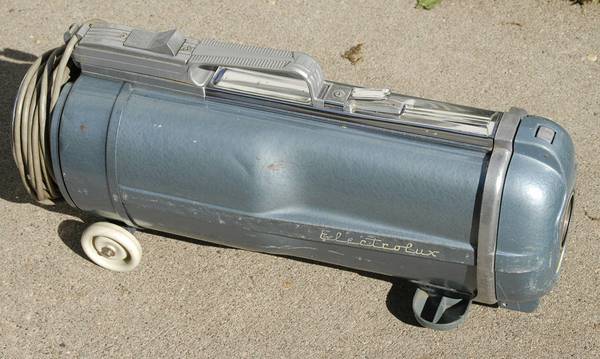
| ||
| Post# 235373 , Reply# 1 6/5/2013 at 19:14 (4,069 days old) by vacman1961 (North Babylon, New York) | ||
|
Definitely not original, actually they look like replacement wheels and the axels aren't even original, the original Electrolux axels are peened over at the ends, they never used removable caps. | ||
| Post# 235425 , Reply# 3 6/6/2013 at 10:39 (4,068 days old) by dysonman1 (the county) | ||
Automatic E | ||
Post# 235446 , Reply# 4 6/6/2013 at 14:31 (4,068 days old) by Electrolux137  (Los Angeles) (Los Angeles) |
||
 | ||
| Post# 235449 , Reply# 5 6/6/2013 at 14:42 (4,068 days old) by dysonman1 (the county) | ||

Would those not have been unsold cord winders from the model LXI? The Automatic E was only out for 2 years - the LXI for one. Surely the company would sell their existing stock, since it did fit the Automatic E. I've seen plenty of those winders on model E's as well, albeit hard wired into the cleaner.
| ||
Post# 235508 , Reply# 7 6/7/2013 at 00:09 (4,068 days old) by electrolux137  (Los Angeles) (Los Angeles) |
||
E, E-A Tom, the plain cord winders certainly could have been left-over from the LXI but if that's the case, they sure had a lot of them left over! I've seen far more of the plain one over the years than the one with the aluminum band. (The band does have a purposeful function btw, as you probably know -- it makes it much easier to fit the two sides of the cord winder together.) I've also seen -- and in fact have two of them -- Model Es with cord winders. One of them is as you described, with the cord hard-wired inside the machine. One of the neighbor ladies in Virginia had that version. She had an XXX hose with it. I didn't understand that until one day I was playing with her two little girls and we went out to their grandparents' barn which was next door. (NO, we were not going to play doctor hahaha!) In the barn I saw a rusty old Model XXX ... with a Model E hose attached to it! What had happened was that the E hose gave out, so the lady took the hose from the XXX for it which was still in good shape. The other version I have is where there's a one-inch cord coming out of the back of the machine with a male Belden plug on it, which plugs into the female plug of the cord winder. Looks more jerry-rigged than the hard-wired version but it did make it easier to remove the cord winder. Paul, if you want to see the Model E to compare it to the E-Automatic, see the link. (btw, when the Automatic model first came out, Electrolux designated it as E-Automatic [see scan below of inside-front cover of the instruction manual]. In later literature etc. the name was changed to Automatic E, although I don't know if that was ever "official" or not. Technically, the F and G were also automatic models but were never, to my knowledge, called "Automatic F" or "Automatic G" since there were no non-automatic versions of those models. So because that model was called the E-Automatic first, that's how I like referring to it.) Following are all the differences between the two models, keeping in mind that the Model E came first (1954). -- Model E front cover comes off when unlatched; E-A is hinged at the bottom and swings open. -- Model E front-cover release latch is a long chrome-plated "finger" on top; Model E-A is a small ridged plastic button in the front cover. -- Model E-A front cover has a yellow dial to adjust when the cover pops open to indicate full bag. This is a "vestigial version" of the bag-ejection mechanism of the LX and LXI. The Model E has no suction control. Model E-A front cover also has the word "Automatic" in yellow lettering. -- Model E plastic handle strip is flat against the top of the motor housing all the way back; Model E-A has a raised area at the back end that contains the switch and plug assembly. -- Model E switch has a small black rubber tip inset into the top of the machine inside a chrome cover plate that pushes from side to side. Model E-A switch has a large silver plastic switch cover that rocks from front to back. It sticks up from the top of the machine so it's easier to turn the machine on and off, especially with your big toe which many people did. And often broke the plastic switch cover! -- Model E has very dense black plastic wheels that almost look like wood (and there were two versions -- see web page). Model E-A has dark blue plastic wheels that are larger in diameter. -- Both models came with a chrome halo for cord storage; an automatic cord winder was optional extra-cost equipment. -- Model E rear wheels were secured to the axle with cotter pins; Model E-A wheels were, as noted above, peened at the ends. That makes it impossible to remove the wheels without wrecking the axle, a somewhat more costly repair job. The black wheels of the E are much more durable - they're of denser material and are thicker in cross-section. I have never seen a broken one. The blue wheels of the E-A (which btw were the same wheels used for the F, R, L and G [the G has chrome hubcaps but it's the same wheel] are rather brittle and will easily break if the machine is dropped on the wheels. -- Both models had the same front swiveling caster wheel (same as used up through the Epic). However, it was soon found that the machine tended to topple over when pulled sharply to one side. So Electrolux added a plastic "stabilizing foot" somewhere along the way of the Model E to help prevent it from toppling over, and that foot was continued into the E-A. -- Hmmmmmm... what else.... OH, the hose! The E had a woven cloth hose, gray with blue chevron pattern. The first E hoses had a hammertone-blue machine-end coupler, the only model to ever have other than a chrome coupler. The E-A had a woven vinyl hose, same color scheme as the E but it looked different since the vinyl material was shiny instead of matte like the cloth hose. The E-A was the first model to have a woven-vinyl hose. [I have an experimental prototype Electrolux hose that has the gray-colored weaving done in cloth, and the blue-colored chevron pattern in blue! The E-A hose is also slightly longer: The E is 6.5 ft. long and the E-A hose is 7 ft.] -- The E hose handle did not have a suction-relief valve; the E-A did (the first appearance of this feature). -- The combination floor/rug tool was the same for both models. However, the E version (first appearance of this attachment) had a friction-fit neck like all the older Lux attachments had. The floor tool tended to come loose and fall off. When the E-A came out, they added a spring-loaded locking mechanism to hold the tool in place, and that tool has a wide collar around the top of the neck where the wand is inserted. -- The dusting brush and (optional!) crevice tool were the same for both models. -- The polisher was the same for the E and early E-A (as well as for the XXX & LX). During the latter run of the E-A, the all-new "Turb-O-Tool" (as it was called back then) was introduced. It was a more versatile attachment and could do a lot of things including operate a circular saw and hedge-clippers! (But the version with the rug shampoo setup did not come out until the Model F.) -- Both models had the same cord, black Belden. However, the Model E cord was "hard-wired" inside the machine and could not be removed. The cord-storage hook on the E is a small somewhat triangular shaped "lip" just behind the handle; the E-A cord hook is integrated into the rear raised portion of the handle itself. -- The E-A is =slightly= heavier than the E but not much. The early E had the same motor as the E (which was the same as the LX and late XXX), then somewhere during the run of the E-A a somewhat more powerful motor was used. -- The E came with a pair of chrome-plated steel wands (same wands used since the Model XII); as did the early E-A. However, during the run of the E-A, lighter-weight aluminum wands were introduced (and were used for all models through the 1993 Renaissance, when plastic wands with electrical connections were introduced). That's all I can think of off the top of my head. Tom, did I miss anything??! CLICK HERE TO GO TO electrolux137's LINK 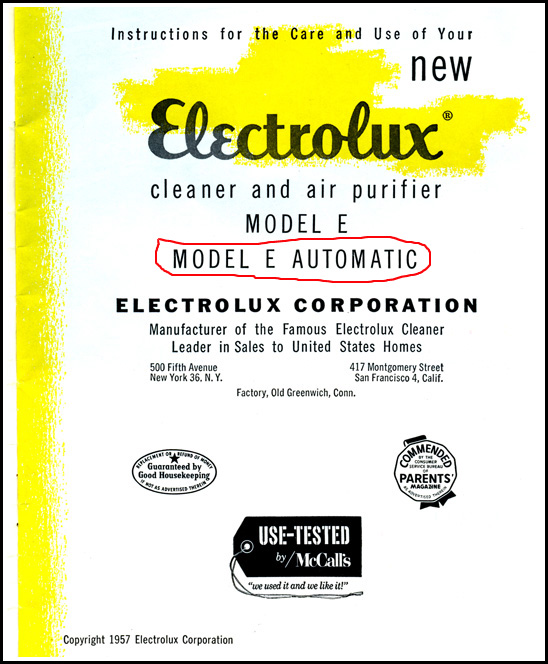
This post was last edited 06/07/2013 at 01:42 | ||
| Post# 235571 , Reply# 9 6/7/2013 at 14:29 (4,067 days old) by dysonman1 (the county) | ||
Automatic E | ||
| Post# 235572 , Reply# 10 6/7/2013 at 14:30 (4,067 days old) by dysonman1 (the county) | ||
Inside of Automatic E | ||
| Post# 235573 , Reply# 11 6/7/2013 at 14:31 (4,067 days old) by dysonman1 (the county) | ||
Hepa bags for Electrolux (C type) | ||
| Post# 235583 , Reply# 12 6/7/2013 at 15:42 (4,067 days old) by luxman107 (USA ) | ||
|
Would love to get mY hand on a excellent condition AE. What memories. | ||
| Post# 235652 , Reply# 16 6/8/2013 at 10:20 (4,066 days old) by westinghouseman (Capron, Illinois, 13 miles due north of Belvidere, Illinois.) | ||

I have a very nice AE all orginal in the box, I will get it out later and take some pictures. The attachments and hose were never used. The attachments are still in the cardboard.
I was told by the owner's son, that his mother used her old Lux 30 attachments and hose with the AE machine. I was lucky to find this vacuum. | ||
Post# 235682 , Reply# 17 6/8/2013 at 12:33 (4,066 days old) by Electrolux137  (Los Angeles) (Los Angeles) |
||
 There were 10-ft.-long "commercial-length" woven cloth hoses for the XXX and LX, each of the same color and weaving as the normal-length hoses. I've never had either one, have seen the LX type twice - once in my childhood on a Model E used in a grocery store, and once in a collector's mind-boggling huge horde of stuff. I was told by a retired Electrolux man that there was an optional longer-length woven hose for the turquoise Model G but, again, I've never seen one -- nor have I come across any reference to one in my archive of Electrolux printed materials (including about a hundred issues of "Electrolux News" from the 1950s to the 1970s). | ||
| Post# 235728 , Reply# 18 6/8/2013 at 16:18 (4,066 days old) by luxman107 (USA ) | ||
|
Would love to see pictures Ken as soon as you get a chance to post them. Thanks | ||
| Post# 235733 , Reply# 19 6/8/2013 at 18:24 (4,066 days old) by dysonman1 (the county) | ||
@Charles | ||
| Post# 236580 , Reply# 21 6/15/2013 at 00:06 (4,060 days old) by Collector2 (Moose Jaw, Sk) | ||

Just to throw another version into the works here. The AE was also briefly sold in Canada in the mid 50's to see how the new style paper bags and automatic bag controll would go over with consumers here. The dual accessories, however, were considered a step down here and only sold with the bottom of the line model Z54. Consequently the AE in Canada came with a full set of parts including vaporizer and sprayer as seen in this picture from the cover of its instruction manual. Note it also has the cord reel without the silver band.
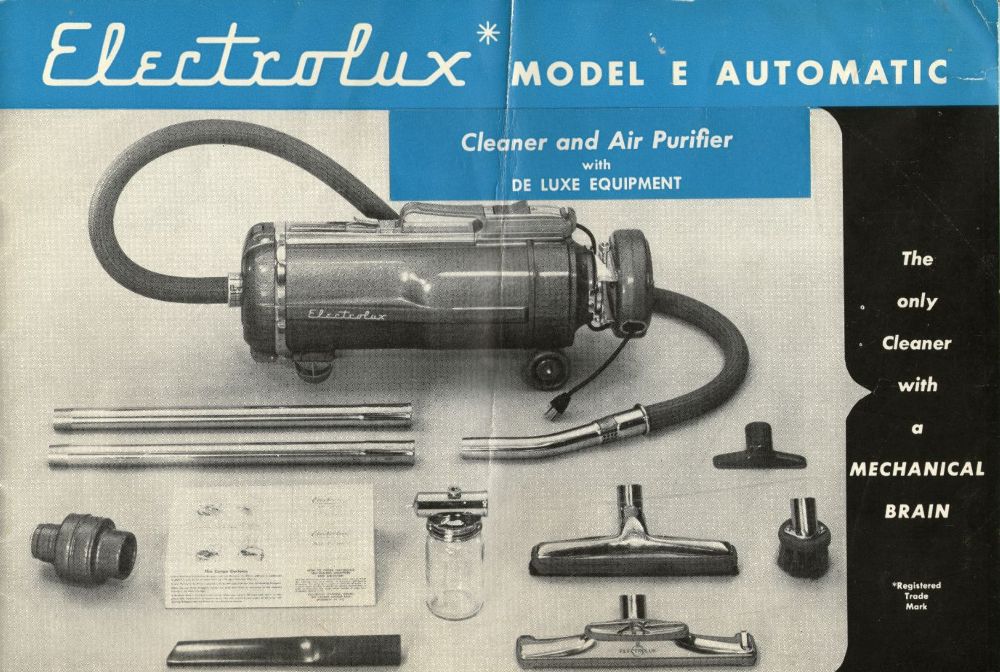
| ||
| Post# 241259 , Reply# 22 7/21/2013 at 16:58 (4,023 days old) by floor-a-matic (somewhere) | ||
|
Another variation of the AE is some have a small "box" underneath the front of caster that has PN receptacle; which was done by Lux service centers. Are there any AE Luxes anywhere else besides USA & Canada? This post was last edited 07/21/2013 at 22:56 | ||
| Post# 241265 , Reply# 23 7/21/2013 at 18:17 (4,023 days old) by dysonman1 (the county) | ||

@floor-a-matic: There were no Automatic E Electrolux vacuums with a power nozzle receptacle by the wheels unless it was 'rigged' by a vac shop. The top trim with the receptacle was available for the Electrolux salesmen to retrofit an AE when the PN-1 came out with the Automatic F in 1959. The Power Nozzle hadn't been invented when the AE was on the market.
| ||
Post# 241497 , Reply# 24 7/22/2013 at 13:56 (4,022 days old) by Electrolux137  (Los Angeles) (Los Angeles) |
||
 floor-a-matic, might you be thinking of the standard Model E? I've seen a few of them with rectangular PN receptacles on the bottom, retrofitted by Electrolux branch office service centers. I'll see if I can dig out a photo of one - I know I've got one on here somewhere. [Pause, play Final Jeopardy music in your head...] Ah yes, here it is. This little box first appeared on the Model R btw, and was also used on the Model L. The power cable ran along under the bottom of the machine in the long narrow channel that leads from the PN box to the rear under the motor. This type of PN connector =could= have been installed on an E-Automatic but I don't see why a service or repair center would have bothered, since it would have been so much easier to use the type that's in the metal trim piece on the top of the motor housing. 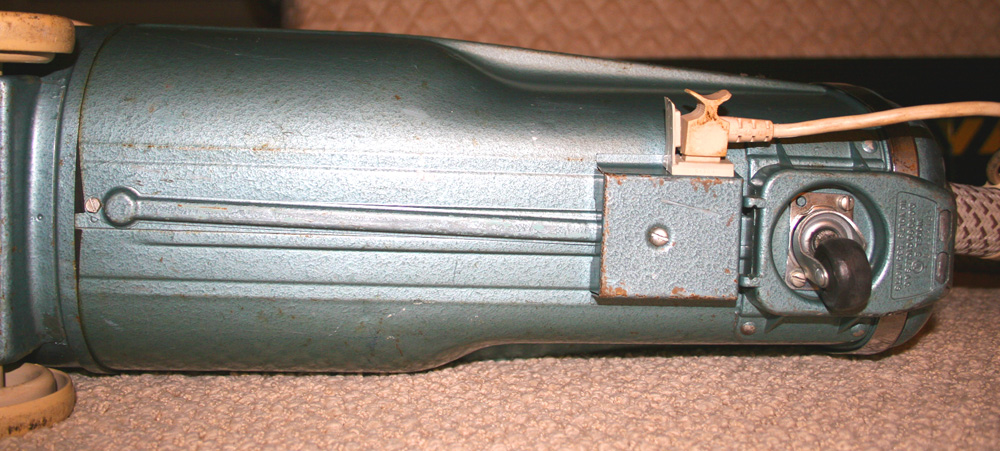
| ||
| Post# 241578 , Reply# 25 7/22/2013 at 20:02 (4,022 days old) by floor-a-matic (somewhere) | ||
|
Years ago my parents had a Automatic E with PN port box underneath the unit; but I'm 100% sure its been installed by Lux dealer, since the PN wasn't available during the time span of the E & AE. | ||
| Post# 260102 , Reply# 26 12/19/2013 at 00:29 (3,873 days old) by floor-a-matic (somewhere) | ||
|
I wonder if any Automatic E luxes were sold in Mexico & Central & South America? | ||
| Post# 459458 , Reply# 27 1/14/2023 at 09:44 (559 days old) by 2011hoover700 (owosso michigan) | ||
 | ||
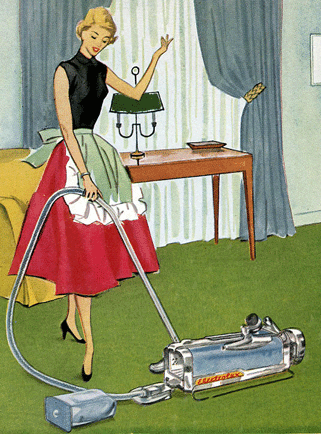
 Comes to the Rescue!
Comes to the Rescue!